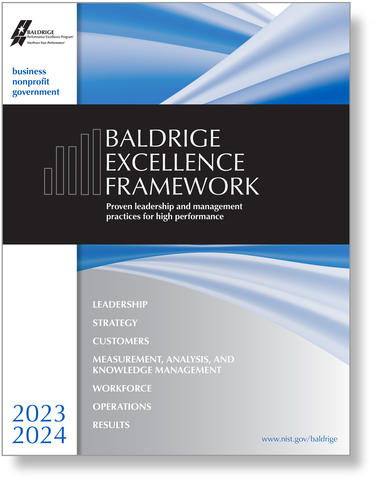Blogrige
The Official Baldrige Blog

“Every organization has countless opportunities for improvement, but only a few points—what we call constraints or bottlenecks—govern the pace and performance of the entire system,” said Rami Goldratt, who gave the closing keynote presentation at the Baldrige Performance Excellence Program’s 36th Quest for Excellence® Conference last week. “When we identify these points and enable smooth flow through them,” he continued, “we not only accelerate throughput but also unlock significant gains in quality, innovation, and competitive advantage.”
Goldratt helps organizations achieve such gains through implementations of Theory of Constraints (TOC)—the body of knowledge that his father, Dr. Eliyahu Goldratt, developed and introduced in his book The Goal. Rami then developed applications of TOC for sales and marketing.
“At its heart, TOC is about focus—specifically, how to focus limited management attention on the few areas in a system where it will make the most impact,” Rami Goldratt explained.
During his presentation, he shared the latest advancements from his work of implementing TOC across diverse industries. Those advancements, he said, include “case studies and hands-on exercises we’ve developed through our training and consulting programs.” He added that his aim was to give conference participants “actionable insights and practical tools to help [their] teams achieve more with less—faster.”
“These ideas are deeply complementary to the Baldrige Performance Excellence Program’s mission of performance excellence,” said Goldratt.
Following are questions and answers from a recent exchange I had with Goldratt in which he provided additional insights about his work.
What experiences inspired you to develop TOC implementations for sales and marketing?
When TOC was first introduced, its early successes came from the manufacturing world. But over time, we realized that the same underlying logic applies to any system—including those where the constraint isn’t a machine or a work center, but rather, management attention, sales capacity, or market demand.
The turning point for me came when working with companies that had world-class operations but were still struggling to grow. It became clear that sales and marketing often lacked a clear, focused process to generate reliable flow—of leads, of deals, of value. Instead, there was a flood of activities and messaging, but very little leverage. In the end, without growth in sales, the hard-won operational improvements couldn’t be sustained. They simply collapsed.
That’s when we began developing TOC-based applications for sales and marketing teams—frameworks to identify the real limitations on the customer side (to craft compelling value propositions) and within the sales operation itself (to streamline the sales process and create reliable flow). These approaches delivered significant results across both business-to-business (B2B) and business-to-customer (B2C) environments and have since become an essential part of the broader TOC toolkit.
Would you please speak more about how standardization in organizations affects flow?
Across industries, we consistently see recurring obstacles that block flow—obstacles that leaders recognize but often underestimate in terms of their full impact. My keynote highlighted several of those “flow blockers,” which we’ve seen repeatedly in both small and large organizations.
Let me expand on a very common obstacle to flow: standardization. As organizations grow, the drive to standardize is natural. Standardization enables repeatability, quality control, and scalability. But in environments like information technology, research and development, engineering, and services, it is very challenging. In these settings, the work is inherently non-standard. The same task can be done in many ways—and often, it’s being done for the first time. That’s why we rely so heavily on our experts—those with the experience and judgment to handle the variability.
These few experts are expected to train others, solve problems, write standard operating procedures (SOPs), and manage complexity. But as demand increases, they become overwhelmed. The queue of work waiting for their attention grows exponentially. Eventually, the system can’t wait. Under pressure, less-experienced staff are forced to take on tasks without sufficient guidance. Mistakes follow. Rework piles up. And who must step in to fix it? The same experts—now even more overloaded. A vicious cycle emerges. Instead of creating flow, the system turns into a game of whack-a-mole.
So how can organizations break that cycle?
We can’t simply impose standardization in environments where the work resists it. The answer lies in scaling the experts—not through more SOPs, but by better leveraging their time and judgment to prepare and supervise others, and to build systems that enable fast learning.
In my presentation, I stressed how to break this cycle [by standardizing to scale] as it is among the most common across industries and environments. Here are more examples of ways to address flow blockers:
- Reduce bad multitasking.
- Segregate big and small tasks.
- Triage projects.
- Increase work dosage.
- Synchronize resources and activities.
- Aggregate and manage time buffers.
- Pool resources.
Readers: What are your organization’s bottlenecks? Have you considered how the Baldrige Excellence Framework® and TOC or other complementary tools can help you overcome them?
New Framework Available: Fall 2025

2023-2024 Baldrige Excellence Framework®
The Baldrige Excellence Framework® has empowered organizations to accomplish their missions, improve results, and become more competitive. It includes the Criteria for Performance Excellence®, core values and concepts, and guidelines for evaluating your processes and results.
Purchase your copy today!
Available versions: Business/Nonprofit, Education, and Health Care





